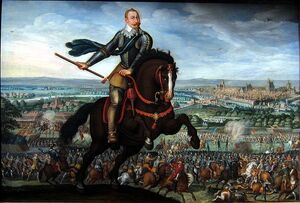| Battle of Breitenfeld | |||||||
|---|---|---|---|---|---|---|---|
| Timeline: | OTL/1632 series | ||||||
| Part of The Thirty Years' War | |||||||

| |||||||
| |||||||
| Belligerents | |||||||
|
|
Catholic League | ||||||
| Commanders and leaders | |||||||
| Gustavus Adolphus of Sweden John George |
Count Tilly | ||||||
|
| |||||||
|
| |||||||
|
| |||||||
The Battle of Breitenfeld was fought at the crossroads village of Breitenfeld near the walled city of Leipzig on September 17, 1631 (N.S.).
Under the leadership of King Gustavus Adolphus of Sweden, the Protestant forces, which had previously been steadily and systematically defeated, achieved their first major victory during the Thirty Years' War. Afterwards Gustav II Adolf became famous and known soon thereafter as Gustavus the Great. The key outcome was that it ensured that the Germanies would not be forcibly converted to Roman Catholicism or remain subject to the Holy Inquisition— that Gustavus had all but destroyed a Catholic field army (for the first time in over a century).
The victory confirmed the Swedish king as a great tactical leader and induced many Protestant German states to ally themselves with Sweden against the German Catholic League led by Maximilian of Bavaria, and the Holy Roman Emperor Ferdinand II of Austria.
Battle of Breitenfeld in 1632[]
Despite the presence of the time-displaced West Virginia town of Grantville, the Battle of Breitenfeld occurred as it did in the original history. Grantville privately sided with Gustavus Adolphus at this time, knowing that his victory would take pressure off of Thuringia. However, word of Grantville had not quite reached Gustavus (or his enemies, for that matter) by this point, so Grantville played no role.
After Saxon troops under Elector John George were routed, General Horn's Swedish forces successfully refused the flank and stymied the advancing Catholic forces, locking them up and blocking their ability to advance. General Torstensson's vastly superior artillery pounded the Catholic infantry who were advancing on Horn, shredding the tercios, but not stopping the advance. Horn, using the shallow formation favored by Gustavus, was able to hold off those who reached his lines.
With Pappenheim's Black Cuirassiers having been driven from the field, Tilly was unable to prevent Gustavus from using his right wing to exploit the disarray on the Catholic left flank. Gustavus personally led a charge around the Catholic flank aimed at capturing Tilly's artillery. This was successful, and since the Swedish cavalry was cross-trained as artillery, the captured artillery were turned on the hapless Catholic infantry.
Still, Tilly was determined to hold until nightfall, rather than surrender, knowing that darkness would keep the Swedes from pursuing. At dusk, Tilly was wounded and lost consciousness, which started a rout of the surviving Catholic forces. However, they were not pursued.
Literary Comment[]
The fictionalization of the account of this battle is primarily limited to character development of Gustavus and his staff and generals via dialog among participants. The resulting word picture is a gestalt of the known historical facts (from post-mortem or after action reports, and many years of informed debate on this world-shaping event) interleaved with character building, which became the series' depiction of the personality and behavior of Gustavus and several other figures who also play a part in the series.

